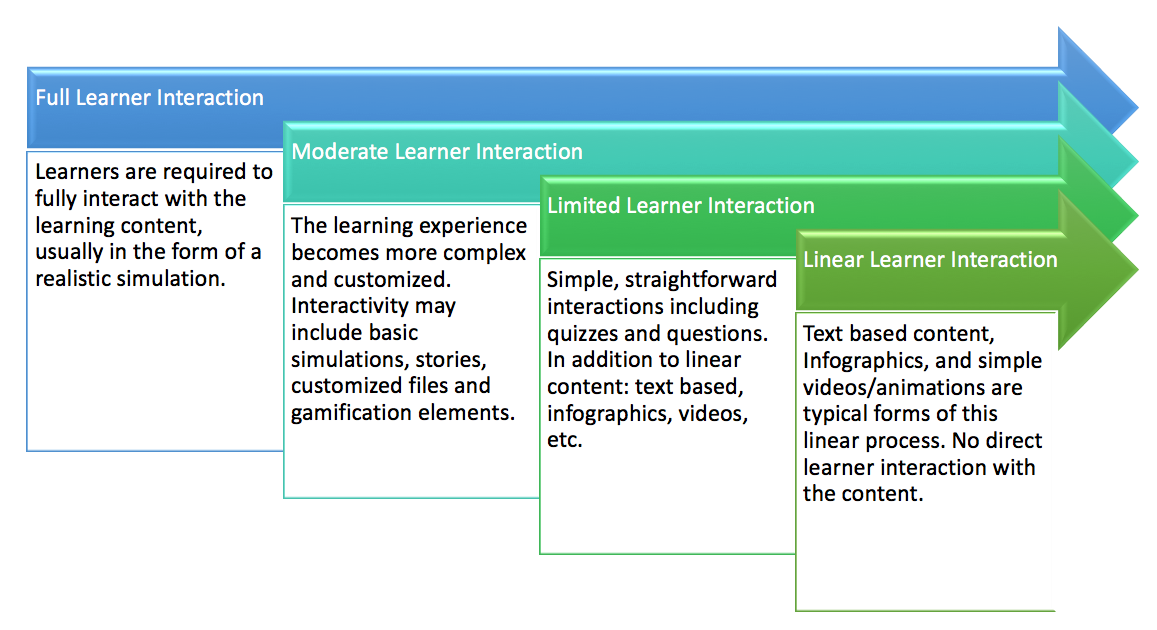How to increase learner engagement in online courses
A blog post by Adriana Lopez Forero, CEO, Onlea Corporation
Have you ever taken an online course that was so boring you left the course 10 minutes in? In contrast, have you had an eLearning experience so engaging that you not only finished the course, but recommended it to your friends?
What are some key differences between these two types of online courses? Can you recall what kept you engaged with the content?
At Onlea, we specialize on the design and production of highly engaging digital learning experiences. That’s why, when our clients in business and academia come to us, they know that we will tailor the experience to their audience and their goals in order generate active engagement with the content.
One of the first exercises we have with our clients is identifying the type of content and interaction required for the subject matter at hand. No single size fits all when you are talking about eLearning.
Interactivity is one of the multiple tools used to create outstanding learning experiences. As such, it is important to know at a high level how learner interactivity affects engagement.
A simple way to understand Learner interaction is on a continuum between content delivery framework and the level of customization associated with the interaction. As such, there are four types that are industry standards as shown in the following graphic.

Each of these interaction types will result in a high quality learning experience if done properly and in alignment with the goals for the course. So how do we achieve learner engagement for each of these types? Below are some examples of how to engage learners at each stage:
1. Linear Learner Interaction:
Since the learner is passively acquiring knowledge in this scenario, keeping engagement high is key. Some mechanics used to achieve engagement include:
- Keep each unit short (5 minutes or less). This means breaking larger concepts into smaller ones.
- Find a relatable presenter and/or style suitable to the audience. As an example, teenagers listen to other teenagers better.
- Add direct examples from the field such as: expert interviews, demonstrations, on-location walk-throughs, etc.
Examples:
- Net Zero Housing: https://youtu.be/dW-qwuApEP4
- Python Programming Language Tutorial Video: https://youtu.be/9RocIiayZa0
- Astronomy 101: https://youtu.be/AEaUnlkOQ18
- Graphic Design Fundamentals: https://youtu.be/zz-pgLDr1t0
2. Limited Learner Interaction:
Engagement can start to come from the interaction between the eLearning module and the learner. You want to engage the learners mind with quizzes and thought provoking questions. Some elements to increase engagement:
- Ask questions that the learner has not directly learned yet, but which are directly tied with the content coming up next. This method engages the learner by creating a framework where they have to think ahead and use the basis learned so far.
- Find a balance between too easy and overly complex. Quizzes (as opposed to the final evaluation) are meant to be doable and generate a sense of achievement and progression.
Examples:
3. Moderate Learner Interaction:
In this type of interaction, learner’s creativity starts to become the source of engagement. Group projects and small simulations can tie together the concepts learned throughout the course.
Examples:
- Case Study Simulation: http://interactive-learning-objects.onlea.org/decision-tree/#/decision-tree/loose-canon
4. Full Learner Interaction:
In this type of eLearning modules, full simulations enhanced with gamification techniques can lead to unique learning experiences. The use of new technologies including Augmented and Virtual reality, can add to the toolset of engagement mechanics in this area.
Examples:
- Release Planning Simulation: http://interactive-learning-objects.onlea.org/release-planning
- Escape Velocity Simulation: https://black-holes-interactives.onlea.org/escapeVelocity/
For more information on this topic, here is another blog on the subject:
https://elearningindustry.com/elearning-interactivity-the-ultimate-guide-for-elearning-professionals
Now that you have some of the basics in mind, you can identify what type accomplishes the goals set forth for the learners in your organization.
At Onlea, we are here to support your team on the development of engaging eLearning courses. Onlea has achieved international recognition for reaching staggering engagement and completion rates by learners of our clients’ courses. Our course completion rates are typically three to four times higher than the industry average for free courses.
How do we achieve much greater engagement rates in our courses than other eLearning creators? We call it O.N.E. Learning, which we define as a narrative based learning methodology that combines insights from gamification and online behavior patterns that allows us to craft superior learning experiences where interactivity and engagement is front and center. In turn, that interactivity serves to enhance the learning experience where learners are able to more readily understand and remember the message.
More thoughts about the importance of learner-centric desing in our blog post about education vs. enterntainment.
To learn more, send us a message at info@onlea.org